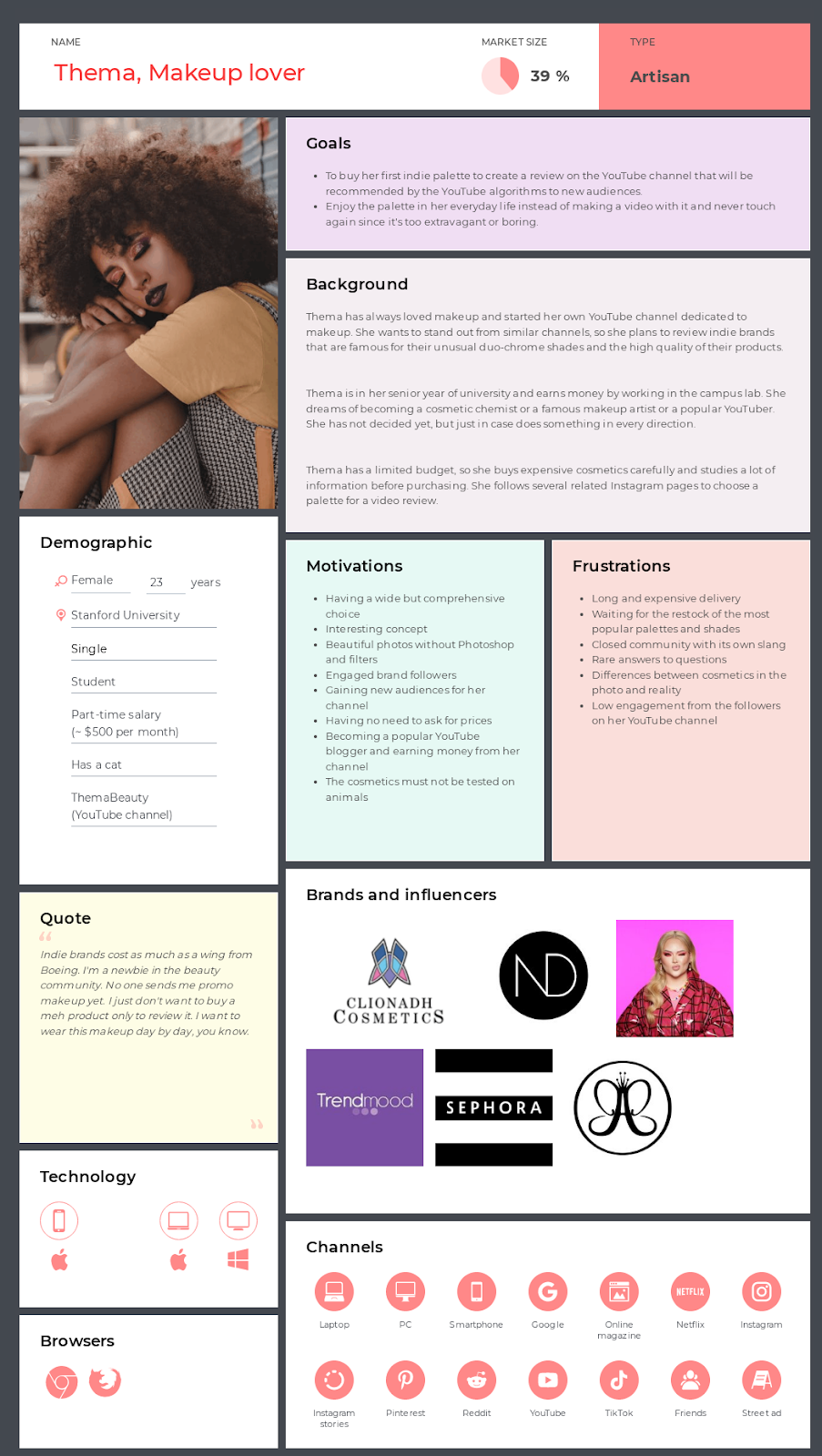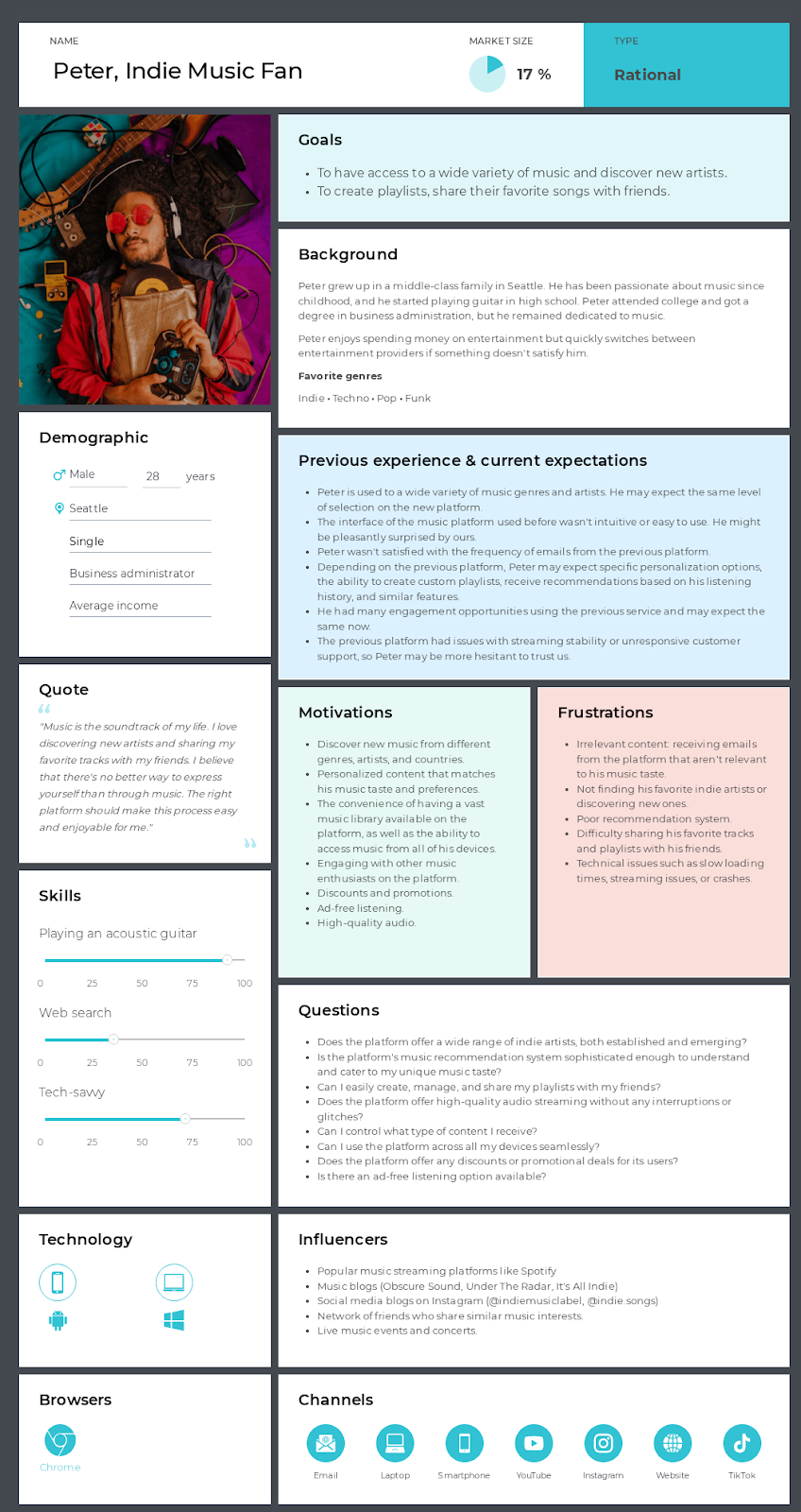Ever wonder why some brands just 'get' you? It's like they're reading your mind, right? Well, there's no magic involved, just the power of knowing your target audience: their needs, wants, motivations, frustrations, jobs to be done, and so on. That's where marketing personas come in, a super handy tool that's like your go-to cheat sheet for everything you need to know about your audience.
In this article, we’ll talk about the advantages of personas, describe the process of building a marketing persona, and discuss how to use a persona in marketing.
Contents
What is a marketing persona? Why is it important?

Think of marketing personas as your secret recipe for success. They are like detailed character sketches but for your target audience segments. Personas form a vivid representation of your customers, encompassing their goals, preferences, challenges, motivations, and other relevant information.
To understand the advantages of creating a marketing persona, consider the following points:
- Clarity and focus: An effective persona acts as a guiding star for your marketing strategies, ensuring that your campaigns, content, and messaging consistently resonate with your audience.
- Relevance and engagement: Deeply understanding your customers allows for marketing that truly connects, addressing their specific needs, wants, and jobs to be done.
- Cutting through the noise: A well-developed persona helps your brand stand out by fostering genuine connections.
- Building relationships: Beyond selling a product or service, it's about establishing trust-based relationships. Customers who feel understood are more likely to engage and stay loyal.
A persona in marketing is more than a tool; it's a foundational element of a successful, empathetic marketing strategy that deeply resonates with your audience.
How to build a marketing persona?

Whether you are going to use a persona in digital marketing, offline marketing, or a combination of both, the persona development process should comprise distinct steps.
Step #1: Customer research
Accurate personas are based on research findings and actual data, not educated guesses. So, where to look for data? Well, there are plenty of sources, just like the ones below.
- Data from customer-facing people
Some people on your team directly communicate with customers: salespeople, support agents, social media managers, etc. They will share their perspective on who your customers are, their goals, pain points, and motivations.
Your colleagues will also provide quotes from emails and support logs, recordings of demo sessions, and other valuable information coming directly from the target audience.
- Polls, surveys, and other data
Businesses research their customers regularly or from time to time. Or at least conduct user testing sessions when working on a new product version. So check your organization’s digital shelves for poll and survey results, recordings of customer interviews, user testing session videos, and other relevant materials.
- Analytics
Google Analytics, Mixpanel, Hotjar, Microsoft Clarity, Adjust, etc. Chances are, you use at least one of these tools or their alternatives to get insights for your business. Why don’t you use it to better understand your customers’ behavior?
- Customers
Talk to your customers. Real conversations with your clientele are an invaluable source of data you must not overlook to get a complete picture of your target audience and/or typical users, as well as their goals, tasks, pains, and needs.
Step #2: Segment and prioritize
A marketing persona cannot represent your entire customer base or one individual customer. It should be a representation of a meaningful customer group: customers who have similar goals, characteristics, and/or behaviors.
You can use a segmentation approach that fits your marketing needs best. For example, if you want to use personas in digital marketing activities, like a targeted advertising campaign, demographic segmentation will be a good choice.
Prior to turning customer segments into persona profiles, it’s essential to decide whether you need a persona for each segment or are going to focus on some of them. For example, if some segments are not very profitable and have limited potential, it’ll be wise not to concentrate on them.
Step #3: Decide on marketing persona sections
Your persona profile layouts will vary depending on the tool you choose. In this article, we’ll use UXPressia’s Persona Editor to build a marketing persona.
The structure of your persona will also vary depending on its purpose. So, be sure to include all the relevant information in the profile.
When it’s finished, you will have something like this:
Expert tip: For a more realistic and engaging persona, consider adding expert-level details, such as a real person's photo, a name that feels authentic, interview notes, and direct quotes. These elements will give your persona a human touch and make it easier for your team to relate to.
Step #4: Populate persona sections with data
As already said, the choice of sections will depend on the persona’s purpose, but you’ll definitely want to include some of these:
- Name and photo
Giving your marketing persona a name and adding a human photo will help you drive empathy and make it memorable. When naming your persona, you can follow this formula:
First name + last name (optional) + short name describing the group
Example: Peter, Indie Music Fan
Don’t use the name or photo of a real person you know (e.g., your first teacher or a movie star), as associating the persona with this specific human being won’t do you a good turn. Staged photos won’t work either — they are too artificial to help you develop empathy.
- Personality type
Specify the persona’s personality type to get one more angle to look at your personas and differentiate between them.
- Demographic details
These can be age, gender, location, job title, and so on—anything you need to make the most of your persona in marketing. For example, you can use this information when launching ads on Instagram.
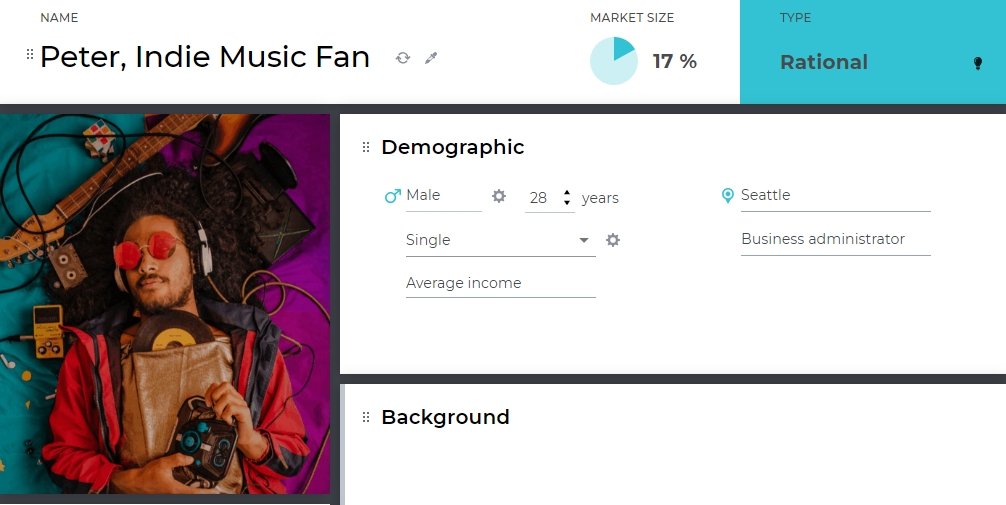
- Background information, context, and previous experience
Context and background information about your marketing persona will help you determine how they would interact with your product or service, who they are, and what brought them to you. Having details about their previous experience with your alternative can be useful as well for your marketing purposes.
- Goals
Each persona has their own goals, and it’s important to know how they align with yours. For example, our marketing persona, Peter, has two goals:
- To have access to a wide variety of music and discover new artists.
- To create playlists, share their favorite songs with friends.
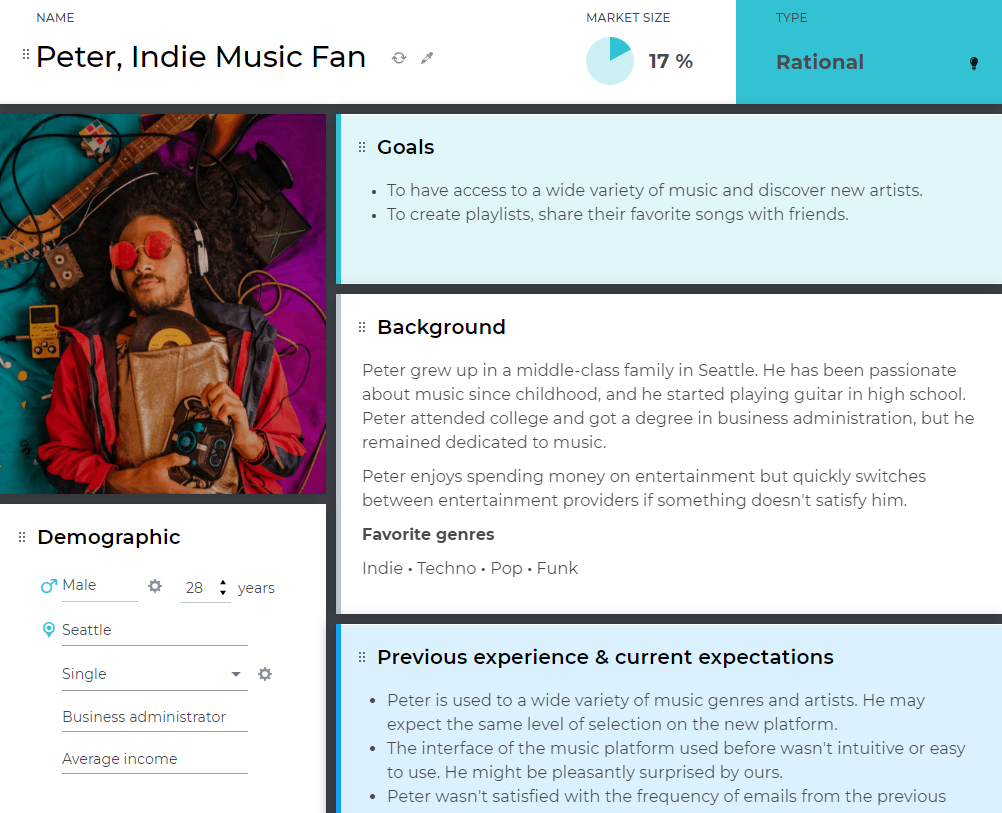
- Motivations and frustrations
Things that motivate and frustrate your target audience will help you develop a better marketing strategy. So be sure to include them in your marketing persona profile.
- Channels and touchpoints
What channels are best for reaching your target audience? What are typical touchpoints to take into account in your marketing strategy? Make your persona a go-to source for this valuable information.
Read also: Differentiating between channels and touchpoints
- Influencers
Who are the people and/or brands that have the most impact on the persona? Considering this data will help you, for instance, come up with a collaboration idea with some brands, potentially bringing a larger number of customers from your target audience segment.
- Quotes
Having a section with customer quotes will allow you to use your audience’s language in marketing campaigns, ensuring that they resonate with the people you target on a deeper level.
- Other relevant details
These could be the devices your target persona uses, browsers, search engines, questions the persona would ask, and any other information you will need in your marketing activities.
In the end, you will have a full-fledged profile:
Step #5: Use the power of AI
AI can aid you in building a marketing persona in many ways:
- Use artificial intelligence like ChatGPT to research your target audience.
- Consult with AI when deciding on the sections to have in a marketing persona profile;
- Ask AI to generate marketing materials based on your persona or tweak existing ones.
- Use it to improve your persona and enrich it with new data, just like UXPressia’s AI Persona Generator does.
Examples of creating personas for marketing goals
Creating personas for marketing is a crucial step in understanding your target audience on a deeper level. In this section, you can find ready-to-go examples of marketing personas and how they can help elevate your marketing efforts, ensuring that your campaigns resonate with the right audience.
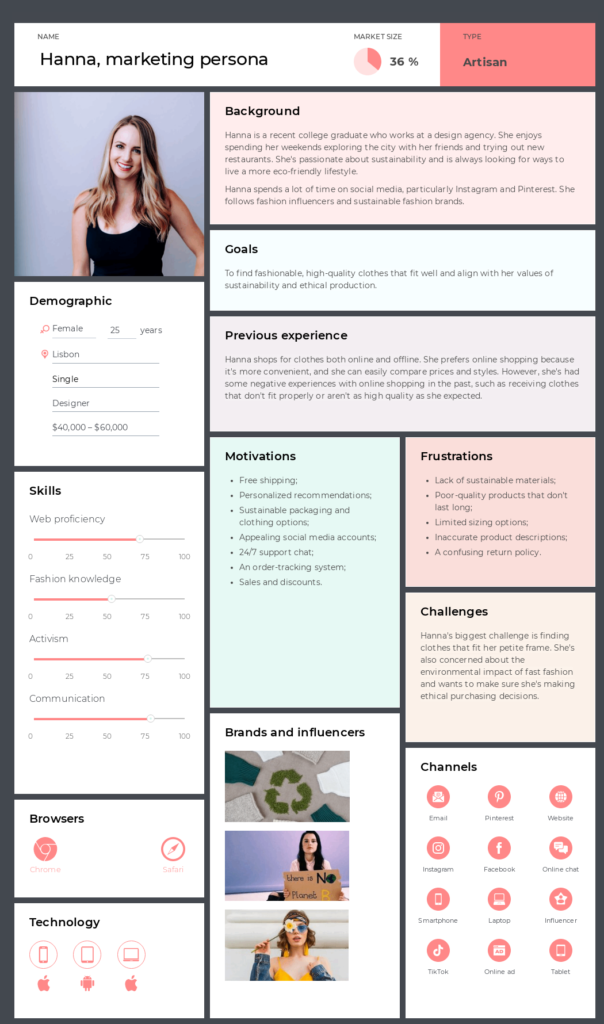
Hanna is a marketing-tailored persona template, that is ideal for businesses focused on clothing sales and distribution. Her profile helps account for all key details, from her commitment to environmental sustainability to the fact that she’s not very fashion-savvy. Information about her favorite influencers and preferred communication channels allows the marketing team to create effective strategies and messages to reach Hanna on a personal level. This persona is invaluable not only for marketing departments but also for sales teams, helping them align efforts to better engage with Hanna. By understanding her preferences, both teams can refine their outreach, develop personalized content, and craft compelling campaigns that resonate. Even product development teams can benefit from this persona, ensuring products meet customer expectations and values.

The next template is a persona representing an entire company, ideal for marketing in the B2B field. This persona is particularly valuable for media agencies that represent the company’s interests in the public space. Using this profile, the agency can clearly focus on the goals of its persona, highlighting key strengths and mitigating potential weaknesses. It allows the agency to better understand both the persona and how to effectively promote it to the target audience. With this persona, marketing messages can be crafted to align perfectly with the company’s vision, enhancing the chances of securing a purchase. This single profile not only helps in knowing the ideal customer but also in creating the right image for the client, fostering the growth of both the client’s business and the agency’s.
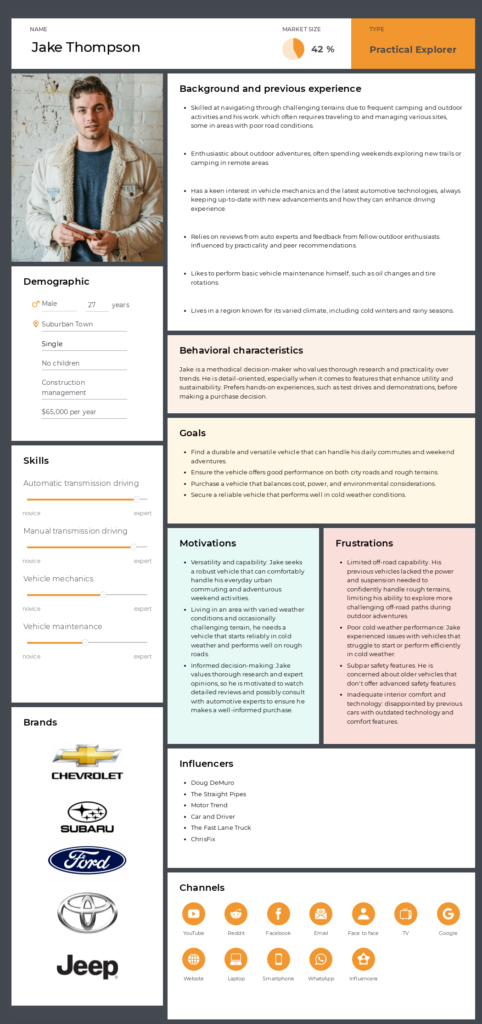
The third example is a persona template tailored for the automotive industry. This template helps businesses understand how to best engage a potential buyer—what interests them, what might turn them away, how to reach them, and through which channels. It also reveals who and what influences their decisions, and even demographic information can be valuable. Creating a target audience persona for the automotive sector provides critical insights, allowing marketers to fine-tune their messaging and strategies. This template lets companies focus on the most relevant factors to attract and convert leads, making it easier to craft personalized experiences that resonate with potential customers.
How to use your personas in marketing: beginner guide

Crafting a marketing persona is just the start. The real magic happens when you weave this persona into your marketing activities. Here are some ideas on using your persona in marketing efforts:
- Customize messaging: Your persona should shape the way you talk in your campaigns, online and offline. Whether your persona responds better to a friendly, informal tone or a more professional approach, make sure your messaging feels like it's speaking directly to them. When doing such customization, persona quotes are super handy.
- Content development: Design the content strategy around your persona's interests and needs. If your persona loves detailed guides, focus on in-depth blog posts. If they prefer quick tips, short videos or infographics might be the way to go. The key is creating content that addresses their specific questions and challenges.
- Targeted advertising: Use the insights from your persona to refine your advertising strategies. This includes choosing the right platforms (like Facebook, Instagram, or Google Ads) and crafting ad copy and visuals that speak directly to your persona's preferences and pain points.
- Email marketing: Tailor your email marketing to suit your persona. Segment your email list based on persona characteristics and send personalized content that aligns with their interests and behaviors.
- Social media strategy: Your marketing persona can guide your social media tone, content types, and posting schedule. Engage with your audience through the platforms they use most and with content that resonates with their lifestyle and preferences.
- Product promotion: When introducing new products or services, consider how they fit into your marketing persona's life. Highlight features and benefits that are most relevant to your persona in your promotional material to make a stronger impact.
By integrating your persona into these key marketing activities, you'll be able to craft more targeted, engaging, and effective marketing strategies. Remember, the better you know your persona, the more personalized and successful your marketing efforts will be. Let's turn those insights into action!
Before leaving, download our Persona Creation Guide to build your persona whenever necessary.

